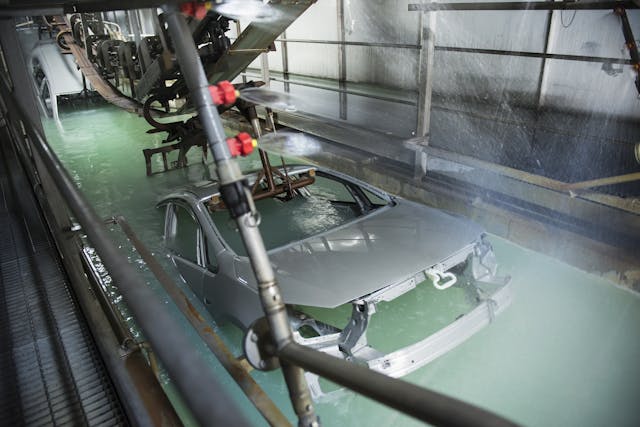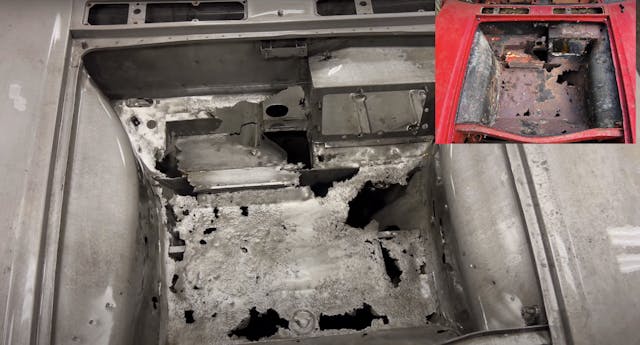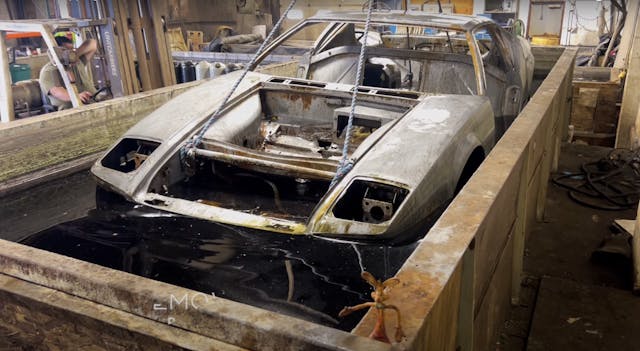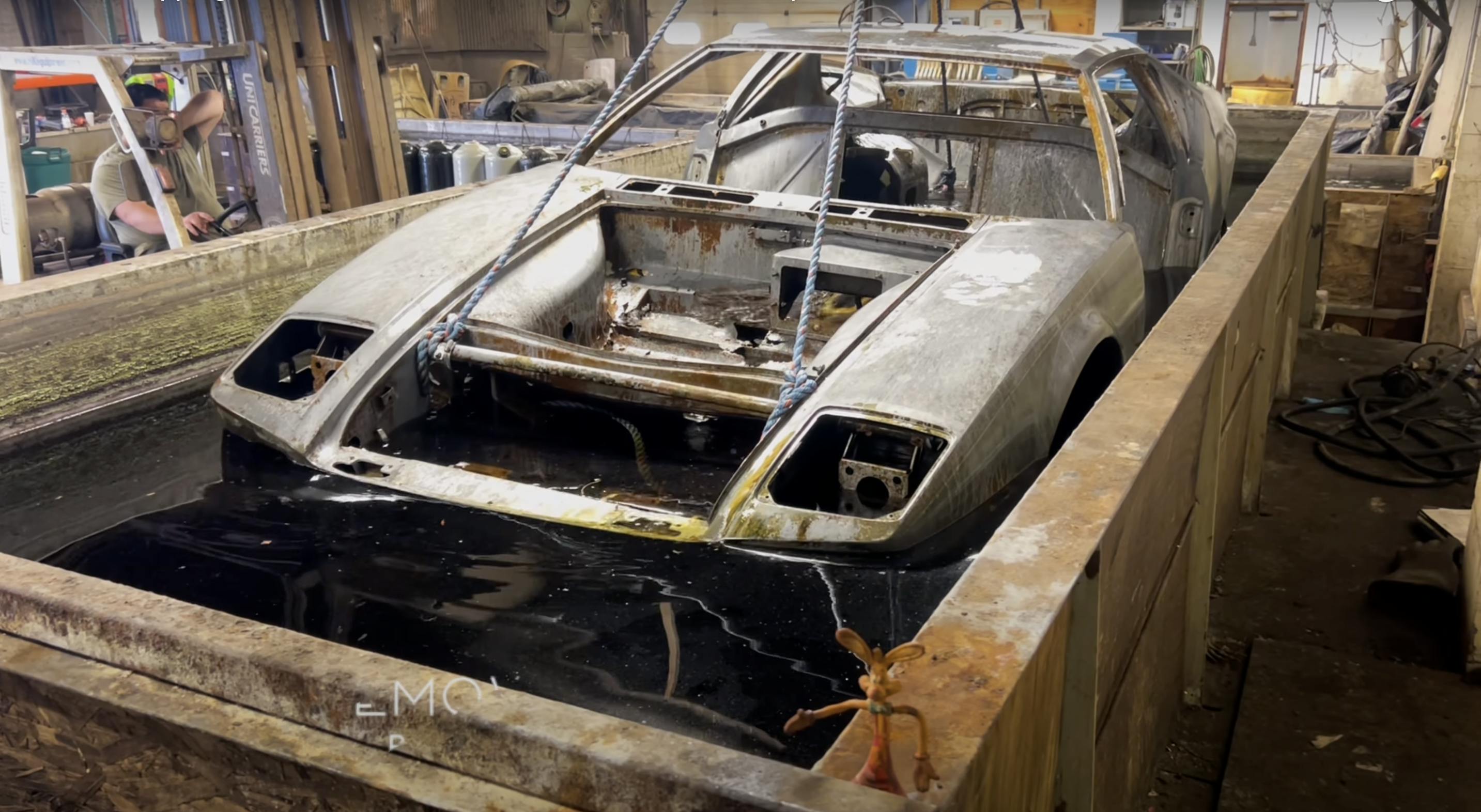Media | Articles
Watch an acid bath free this Pantera from a slow, rusty death
There are few laws of project cars, but one that is undeniable and rules over every single one of us who enjoys turning wrenches is that there is always more rust than it looks like.
Always.
Rust takes away the ability to enjoy working on a car. It makes routine tasks a battle fought with penetrating oil, heat, and large-caliber impact wrenches. It’s a brutal task to cut out the cancer that is iron oxide once it gets a hold of the steel panels. Leave any rust, and it will only come back faster, spreading like that puddle of oil from the time you forget to put the drain plug back in—slowly, but maliciously. If you are going to remove rust, you have to remove all of the rust. If you can’t cut it all out, you have to resort to a more involved process: submerging the whole chassis in an acid dip to remove every last oxidized spec.
The idea of dipping cars in large vats of solutions is nearly as old as the car itself. Assembly lines have been using this method to paint unibody chassis structures for decades. In those cases, the end goal of the process is typically additive; there’s more car coming out the other side of the dip than there was going in. Conversely, When you acid dip a car, you’re looking to remove the paints and finishes that were applied to the body during the production paint dip. These chemical baths remove everything, taking the chassis back down to bare metal.

When doing a very detailed restoration you need to get back to the point of totally clean metal. There are multitudes of ways to strip layers of paint, sealers, primers, body filler, or undercoatings that involve abrasives. Pushing abrasives via air or water comes with the side effects of introducing heat and local pressure, which can warp and damage delicate panels, leaving more work than just hand sanding using a random orbital and sandpaper. Instead, all that labor can be put to better use if you let two large containers of chemicals do the work.
The first tank in the acid dip process is an alkaline bath that works to remove the layers of paint and other surface treatments that may be found on an aging car shell. That soak typically lasts a couple of days, and it’s followed by a rinse with a pressure washer to blast off the paint and undercoating. The bath softens and lifts all the paint but takes a couple of soaks to get it ready for the main feature: the acid dip.
If the thought of a large vat of acid is slightly off-putting, know that you are not alone. The tank is filled with phosphoric acid which is not incredibly strong as far as acids are concerned. In concentrations, it can cause burns to the skin, but this is not some vat of liquid where things go to disappear. Instead, the acid is chemically altering the FeO2 of rust to neutralize it. Effectively, it suffocates and kills rust, leaving behind a neutralized surface.

One final quick dip in the alkaline bath is required to make sure that none of the acid continues munching away at the metal from the inside out. Then a soaking with an electrophoretic paint, known as E-coating, seals all that fresh clean metal and sets a surface that can either be prepped for paint or removed with abrasives to make more extensive repairs.
By the end of the process, you know exactly what you have to work with and can be confident that no rust is hiding in the shadows, waiting to come back stronger. Instead, you have a car that can be protected with modern materials and finishes that could last decades with regular use. We like the idea of that.
***
Marketplace
Buy and sell classics with confidence
Check out the Hagerty Media homepage so you don’t miss a single story, or better yet, bookmark it. To get our best stories delivered right to your inbox, subscribe to our newsletters.












No after dipping pic of the Pantera?
Isn’t that the last photo? Or are you referring to a fully-finished, painted photo?
You have to go to the video for it. It’s worth a watch.
Watch the video that is linked in near top of the article. Strangely pleasing to watch the paint and grime blasted away. The chassis is very clean at the end of the process.
How much does this cost just a rough estimate
This is a must for every rusting Pantera out there. Please protect the breed. If you are proud to have the rustiest Pantera in the world, imagine how much better you would feel with the rust gone. Take it all apart and box up the good, the bad and the not so bad parts. Save a few bucks, get a trailer and take the shell to one of the better dip houses. Then with the rest of your money, get the shell immediately to a good panel shop that will weld in replacements and prime and paint it. That restored body will be priceless. Now take your time and put it all back together. You will thank me later. Put me in your will to inherit the car when you run out of time. Thanks
Interesting video. The one bad thing I have heard about dipping is that sometimes the chemicals are not neutralized and will seep out of seams and crevices running the paint job. Could be urban legend but a very worrisome problem. Any comments?